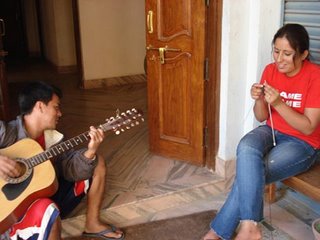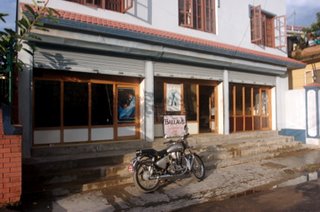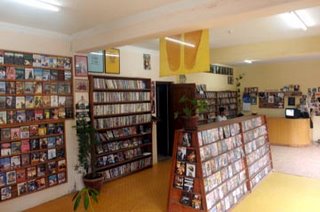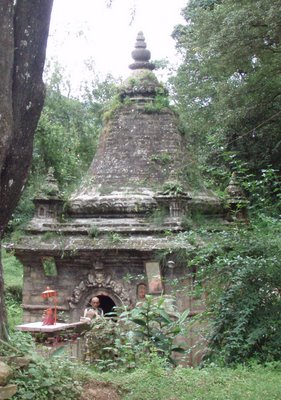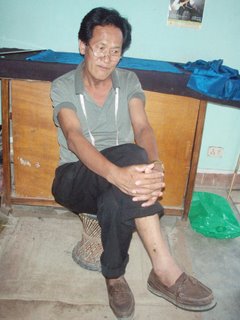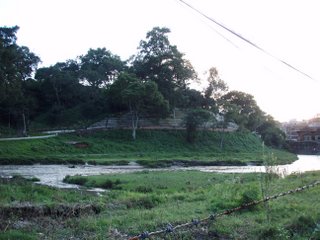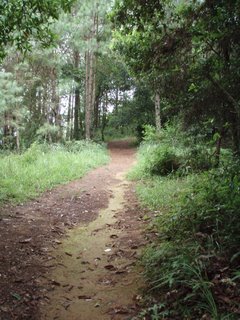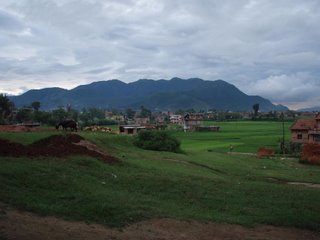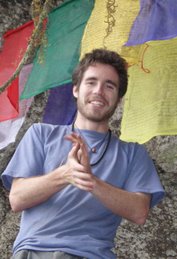 Some yaks with their herders, next to the road that leads to the stunningly located Ganden monastery (in the background), where Tsongkhapa started the monastic reform in tibet that lead to the creation of the gelugpa tradition, the school of the Dalai Lama.
Some yaks with their herders, next to the road that leads to the stunningly located Ganden monastery (in the background), where Tsongkhapa started the monastic reform in tibet that lead to the creation of the gelugpa tradition, the school of the Dalai Lama.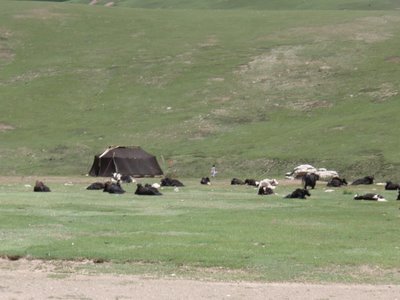 Here is a black nomad tent, made from woven yak wool. Some yaks are grazing nearby. I took this photo on the road to Namtso, Sky Lake, one of the biggest lakes in China, and also one of the highest lake in the world. It is at about 19,000 feet above sea level, over 4000 feet above the highest peak in Colorado!
Here is a black nomad tent, made from woven yak wool. Some yaks are grazing nearby. I took this photo on the road to Namtso, Sky Lake, one of the biggest lakes in China, and also one of the highest lake in the world. It is at about 19,000 feet above sea level, over 4000 feet above the highest peak in Colorado!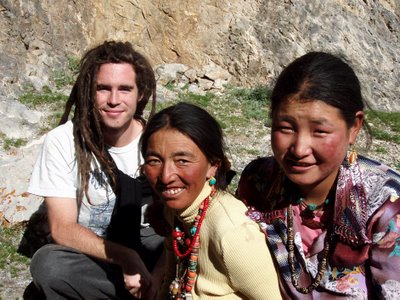 Some kind Tibetan ladies we made friends with near Namtso, the Sky Lake. They had traveled from Derge, Kham, Tibet in order to make pilgrimage around central Tibet. They sold bracelets and necklaces to make ends meet. They had the students and I over to their tiny dirt floored tent (really just a tarp strung over a central wooden pole) for salty buttery Tibetan tea and tsampa (roasted barley flour prepared as porridge or a dough). They gave me some prayerbeads, as they noticed my inclination for such things.
Some kind Tibetan ladies we made friends with near Namtso, the Sky Lake. They had traveled from Derge, Kham, Tibet in order to make pilgrimage around central Tibet. They sold bracelets and necklaces to make ends meet. They had the students and I over to their tiny dirt floored tent (really just a tarp strung over a central wooden pole) for salty buttery Tibetan tea and tsampa (roasted barley flour prepared as porridge or a dough). They gave me some prayerbeads, as they noticed my inclination for such things. The breathtaking Sky Lake during a clear morning. The stars the previous night were amazing, I've only seen them clearer camping in the boulder field below Long's peak in Rocky Mountain Park in Colorado. It is as if the whole sky is awash in silvery threads.
The breathtaking Sky Lake during a clear morning. The stars the previous night were amazing, I've only seen them clearer camping in the boulder field below Long's peak in Rocky Mountain Park in Colorado. It is as if the whole sky is awash in silvery threads.  A cave near the banks of Namtso, with two entrances and a great high ceiling. Good for bouldering or rock climbing, better for meditation! Stinging nettles grow in abundance at the entrance, which were the favorite food of the great eleventh century Tibetan yogi poet Milarepa. He lived on them alone for many years as he practiced in seclusion in the mountains. What a great cave, plenty of water, sunshine and food!
A cave near the banks of Namtso, with two entrances and a great high ceiling. Good for bouldering or rock climbing, better for meditation! Stinging nettles grow in abundance at the entrance, which were the favorite food of the great eleventh century Tibetan yogi poet Milarepa. He lived on them alone for many years as he practiced in seclusion in the mountains. What a great cave, plenty of water, sunshine and food! GO SAINTS!!! The Saints tickets are sold out for the season, something that has never happened before. Maybe God has taken the whole "when the saints come marching in" after the apocalypse to heart this year.
Some of you may have read today about a tragic plane crash in Nepal, that left no survivors. The plane had a handful of extremely talented and affective World Wildlife Federation and USAID, etc. workers. A huge loss for conservation and sustainable development efforts in Nepal. I had the opportunity to meet the US Ambassador to Nepal last night at a reception for this year's Fulbrighters. He lost some friends in the crash, it was a somber mood. I did, however, meet some nice Newar Buddhists who invited me over to their houses, I can talk to them about my project and gain insight and perspective, yay!
LET IT BE A REMINDER TO ALL OF US THAT DEATH CAN COME AT ANY TIME, ALL ASPECTS OF OUR EXPERIENCE ARE IMPERMANENT, DON'T WASTE A MOMENT OF YOUR PRECIOUS HUMAN LIFE!
I also moved into the monastery in Chapagaon on Thursday and am continuously amazed at this amazing opportunity I've been given for quiet study, meditation and reflection. The 30 young monks there are quickly warming up to my presence, and hopefully soon my new camera will come in the mail so I can post pictures of the village and my new robed friends.
